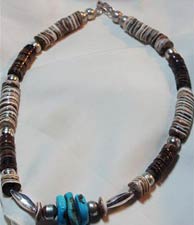
The literal meaning of heishi is “shell” and specifically refers to pieces of shell which have been drilled and ground into beads and then strung into necklaces. More and more frequently, however, heishi (pronounced hee-shee) has come to refer to hand-made tiny beads made of any natural material.
The origin of heishi is fascinating indeed, and is inescapably linked to the ancient history of the people most proficient in its making, the Santo Domingo and San Felipe Pueblo Indians. It is safe to say that this is the oldest form of jewelry in New Mexico (and perhaps in North America), pre-dating the introduction of metals. Centuries ago, the shells used by the Pueblo Indians to make beads were obtained in trade from the Gulf of California.
(Pictured here: Heishi shell necklace with sterling silver and turquoise). When one looks at a string of heishi, the first reaction is frequently “how on earth can a person do that?” or “to be so perfect, it must be done by machines.” The truth is, if it seems exquisitely perfect, it was most likely made by the hands of a highly-skilled, extremely patient craftsperson.
Knowing the steps involved in the creation of a good string of heishi can help a potential buyer distinguish—and appreciate the difference— between excellent hand-made jewelry and imitations. First, the raw materials are chosen. The most commonly used are seashells of all kinds—dark and light olive shells, spiney oysters, mother-of-pearl, melon shell. Coral and stones such as lapis, turquoise, jet, pipestone and serpentine are also used to create exquisite contemporary heishi necklaces. The artisan must pay anywhere from 4-grade lapis or uncut coral.
Now the process begins. With vulnerable fingers on either side of a whirring blade, the raw material is sliced into strips. Next, small squares are made by biting off pieces of the slice with a hand tool such as a nipper. Using tweezers to hold the tiny squares and a dentist’s carbide bur, a small hole is drilled into the center of each square. After these rough squares of shell or stone are strung together on fine wire, the process of grinding, shaping and smoothing is begun.
The artist shapes the string of rough beads by moving the string again and again against a turning stone wheel, controlling the fineness and the diameter of the beads with his hands. At this point, many beads (stone or shell) will be lost–they will chip or will crack and fly off as the grinder catches a flaw or burr. Each type of material must be ground separately. For example, pipestone and jet (high grade anthracite coal) are soft and grind down much faster than the harder materials such as turquoise, shell or lapis. Also, some materials are more difficult to work than others. With natural turquoise, for example, approximately 60-70 percent is lost. To minimize loss, each bead must be nipped into a rough circle before being ground. By now a string of cylinders, often graduated in size, has been formed and is ready for sanding.
The heishi is further shaped and smoothed with ever-finer grades of sand paper. The string is then washed with clear water and put in the sun to air dry. Finally, the string of heishi is given a high polish on a turning leather belt. The smooth, polished beads are now ready to be strung, either together or with other beads, as a piece of fine jewelry.
Following these steps, it will take from 2 days to a week to prepare a single strand of heishi.
What to look for:
A string of good heishi will have a uniform consistency. If you gently pull it through your hand, it should feel like a single serpent-like piece. (Note: Precisely because of the handwork involved, a fine string of heishi may contain a slightly flawed or chipped individual bead.)
On the other hand, inferior “heishi-style” beads will often have holes that are too large, making the strand look and feel uneven and irregular. To make matters worse, this beadwork is frequently made of a variety of plastic materials of all colors, including block or reconstituted jet, coral or turquoise.
In the end, the quality of fine heishi comes directly from the ingenuity and integrity of the individual artisan. Learning something about the artisan, whether he or she has been reviewed by SWAIA remote for acceptance into Indian Market, or is a member of the IACA-Indian Arts and Crafts Association remote are means of assuring that you are buying quality heishi. And of course, an ethical gallery or dealer will help you learn about the artist, the beads themselves and the creative process. The final guarantee is a certificate of authenticity which may be—and should be—requested from the individual dealer or gallery.
(By Pamela Michaelis publisher of the Wingspread publications)





